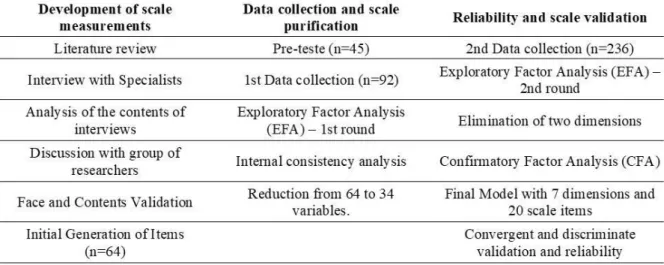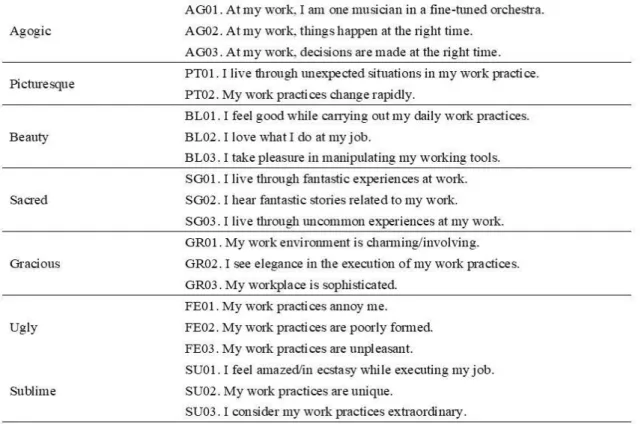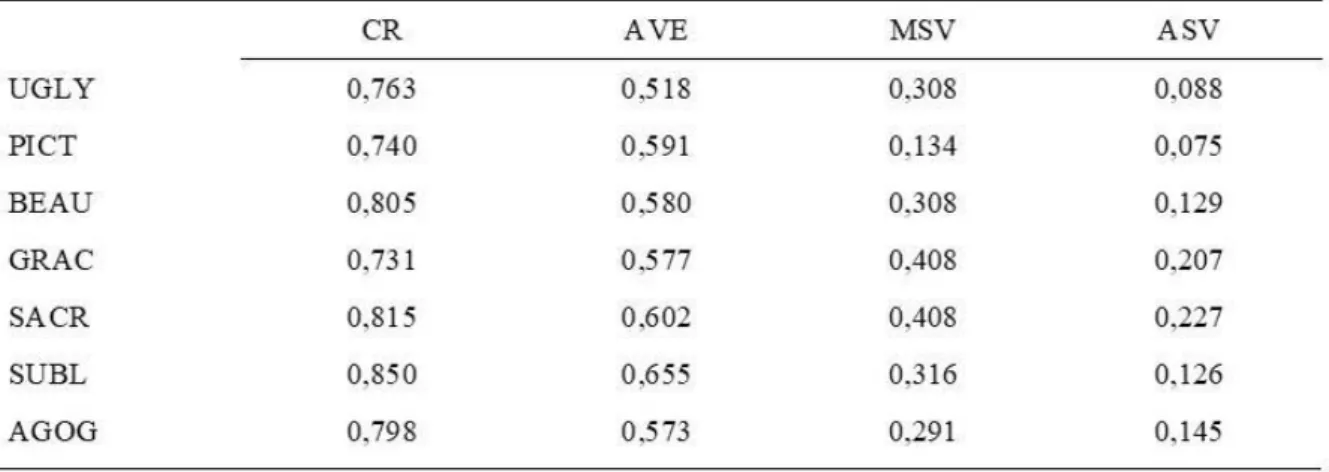Baumgarten (1988) and Kant (1998) are among the leading thinkers of the topic, but aesthetics has recently been studied in the organizational sphere. This means that aesthetic categories emerge when people elaborate their aesthetic judgment about something by creating a network of interpretations valuable for understanding the organization. It is perceived in the elegance of strategic vision, interpersonal relationships in the workplace, courtesy, spontaneity and virtue of individuals.
Aesthetic judgment is the phenomenon that precedes the elaboration of aesthetic categories by individuals and consists of the perception of objects and actions in a given context (Strati, 1999). The development process of the perception scale of aesthetic categories (AESCATScale) contained two separate phases, which followed the structural patterns of scale development by Shimp and Sharma (1987), Vivek and Zheng, Zuh, Zhao & Zhang (2015) (see Figure 1) ). The interviews supported the exploration of the definition of the area of each category and the generation of items in the next quantitative phase.
We concluded that the constructs of organizational aesthetic categories are subjective, complex and multidimensional. This became clear from the analysis of the literature and the language used by the specialists. Each aesthetic category is a formative and latent construct, which includes the dimensions of the aesthetic perception scale (AESCATScale).
That is why we have developed a new version of the research tool with improvements in the context validation session.

Quantitative Study Phase
Overall, there was a good indication of high comprehension of the survey, considering the subjective nature of the items. We wanted to reduce the scale items of each category and verify whether there was factor clustering of the items in each aesthetic category. The selection criteria used were: the highest Explained Variance and Cronbach's Alpha, which revealed the factor with the most important internal consistency in accordance with the literature review (Hinkin, 2005, Costa, 2011, Hair et al., 2006 and Kline, 2015).
During this step, we faced problems with the tragic category: the Kaiser-Meyer-Olkin measure of sampling adequacy (KMO) was 0.612, one of the variables received an MSA inferior to 0.5, low communality in one of the items and Cronbach's Alpha was only 0.529. To solve this problem, we added an extra step to the methodology: we reviewed the literature again and the recordings of the specialists. The main aim of Study 2 was to run a second round of refinement of the scale and verify its reliability and, convergent and discriminant, construct validity.
In the initial data screening of the database, we eliminated one observation due to missing value issues. With this information, we returned to the database and began to identify outliers through the z-score analysis of each of the construct variables. Due to the changes from the procedures of the first round, we had positive results: 76.1% found all items easy to understand (compared to 67.7% in the previous study) and 20.2% had some difficulty with understanding of some items (compared to 29% in the previous round).
In this phase, the EFA confirmed non-observable factors that constitute categories or dimensions of the aesthetic perception. Based on the EFA, even with the extra effort to create the items of the scale, the Tragic and Comic dimensions did not reach sufficient statistics to remain in the model. We believe these problems arose due to the diverse interpretations of the items of the scale, specifically, with the words highlighted: "I mock situations I go through at work";.
This section discusses the results of the Confirmatory Factor Analysis conducted with the seven-dimension scale of aesthetic perception (AESCATScale). The indicators presented by the CFA were verified and proved the validation of the model. The construct validation consists of verifying the measurement behavior related to a specific theoretical expectation associated with the definition of the construct (Costa, 2011).
In this section, the quality of the measurement model convergent validity, reliability, and discriminant validity are examined. In addition, we also did not conduct nomological validity due to the lack of unknown predictors of organizational aesthetics (see Limitations and Future Studies section).

4 AESCATSCALE USABILITY
Since the AESCATS scale is a completely new scale, there are no similar scales to perform the known group method because it involves measuring how an expected group differs from known characteristics.
5 OVERALL DISCUSSION
In addition, we understand that the construct may contribute to future studies that discuss aspects of organizational cultures, such as the relationship between aesthetics, employee personal values, and organizational values. In addition, regarding the interdisciplinarity and the gaps already presented, the construction of the aesthetic categories can be applied to marketing, organizational strategy and public administration to strengthen the student-teacher relationship and develop useful pedagogical practices, among many other possibilities that cannot be covered here. exhausted. We held that the aesthetic experience is a pre-reflexive phenomenon, i.e. it occurs non-intentionally through sensitive experiences and reaches consciousness only after an aesthetic assessment process (Strati, 1999; Taylor & Hansen, 2005).
Thus, we highlighted the aesthetic experiences provided by categories as a preliminary element of aesthetic judgment and even perception. Therefore, aesthetic experiences before categories that form a form of reflection are considered latent in the whole process of sensitive awareness. Furthermore, the aesthetic experience that culminates in Strati's (1999) categories is achieved by measuring, developing and organizing work practices before anything is done (Martin, 2002).
There is also a collective dimension to the aesthetic experience, which is identified in a group context and reveals the sensitive logic behind work practices. Although Nord & Fox (1996) point to a greater interest of researchers in the collective affairs of the organization than in the individuals, the organizational aesthetic establishes the individual as the point of relevance, with personal perceptions seen as predictors of the collective. It results in the identification of the individual with the organization, its values, desires, feelings and sense of belonging.
For this reason, we reinforce the idea that the aesthetic process (experience, perception and judgment) has managerial implications and should be considered by practitioners and managers. The AESCATS scale can be a complementary instrument used to learn about the aspects of the organizational environment. Furthermore, the primary function of the scale is to reveal the sensitive logic underlying several organizational processes, such as practices developed in the workplace, that underlie the company's values, mission, and vision.
It can also effectively reveal a company's underlying organizational structure, as it is not always organized rationally. In terms of management, the AESCATScale is a valuable tool to externalize the aesthetic experience to make it known by them and third parties. It is essential to learn about the sensitive logic that governs organizational practices in the work environment.
6 LIMITATIONS AND FUTURE STUDIES
This study introduces a differentiated approach to organizational management that can sometimes be missed due to its abstract nature. It also provides an aesthetic measurement proposition through items that can be replicated and validated in other contexts and samples in different cultures. Therefore, it introduces a novelty research tool that can be used in both corporate and academic settings.
Reclaiming the ugly: a dialogic exploration of ethics in leadership through an ethno-narrative rereading of the Enron affair. Aesthetics-based competencies lead to sustainable learning practice: rethinking public management through the lens of sustainability. A beautiful strategy - bridging the gap between the perception (aesthetic) and the realization (strategic) of the organization's purpose.
Aesthetic management (AL): development and implementation of aesthetic management scale (ALS) by the school leaders. The role of aesthetics and art in organizational sustainability: a conceptual model and exploratory study in higher education.

